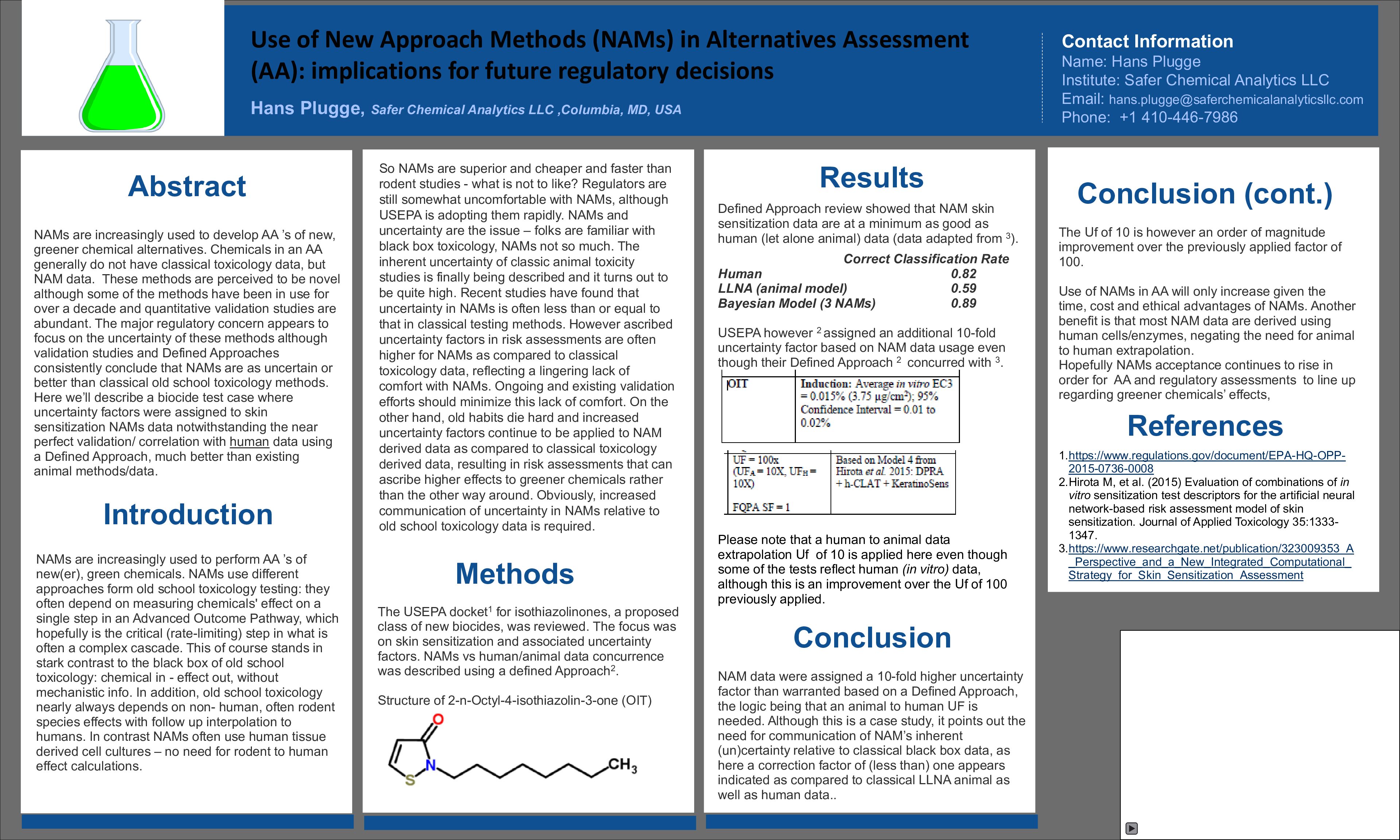Presented at SciCon 4, Society for Environmental Toxicology and Chemistry, Virtual, November 15-18, 2021
Hans Plugge, Safer Chemical Analytics LLC, Columbia, MD 21045
Assessing Alternatives in View of Uncertainty in Toxicological Data: New Approach Methods (NAMs)
Greener chemical alternatives most likely will not have classical toxicology data but NAMs data instead. Comparing health effects between a compound of concern and an alternative thus involves very different methodologies and inherent uncertainties. Hazard assessment as part of an Alternatives Assessment (AA) is based directly on all health (and ecological) effects used in a screening effort. NAMs offer a relatively inexpensive, quick, and ethical opportunity to screen hazards. Positive results/flags would result in elimination of alternatives. Negative results move an alternative forward from an AA to eventually a regulatory submission.
Although existing conventional toxicology data are thought of as “gold” standards, they are much less certain than previously assumed. Recent studies have found that inherent data uncertainties are in the + half order of magnitude range at best and can easily range two orders of magnitude for e.g. fish. These uncertainties already imply that categorization/classifications can span two or more categories. In addition, NAMs can have better concordance and repeatability as compared to animal data. NAMs thus only have to be as good as traditional data, better would be a bonus.
Using an actual biocide evaluation for isothiazolinones, the uncertainty in hazard assessment using NAMs will be described. These chemicals are meant as less toxic alternatives to existing biocides. The hazard assessment of the skin sensitization potential uses a NAM composed of three separate tests in a Defined Approach. Hazard identification did not result in a “flag”. Risk assessment of this group of chemicals (isothiazolinones)’ skin sensitization potential via a NAM included an uncertainty factor of 10,000 despite the NAM’s concordance with human data (much higher than animal models). Based on these hazard assessment data (leaving aside the exposure considerations), the alternatives would incur at least a 100 fold “penalty” as compared to the compounds of concern, even though they passed the hazard assessment phase.
From a regulatory point this has the potential for great inequities – an alternative that has been assessed via NAMs gets hit with an extra (>= 100) fold assessment factor: indicating the regulator/assessor is not comfortable with the NAM methodology. The likelihood thus exists that a new, greener alternatives assessment identified based on NAMs will have equivocal risk rating compared to the compound of concern.
Presented as a poster at the A4 (American Association for Alternatives Assessment) meeting on October 29, 2020 (virtual)
Hans Plugge, Safer Chemical Analytics LLC, Columbia, MD
Use of New Approach Methods (NAMs) in Alternatives Assessment (AA): implications for future regulatory decisions
AA of Green(er) chemical alternatives will be based on NAMs rather than classical toxicology data. NAMs generally provide a faster and more ethical approach to data generation as well as more detailed effects data. Preliminary AA will use NAMs to assess alternatives, except for the compound of concern where both traditional and NAMs data are available.
Following efficacy testing further, more-nuanced NAMs testing has indicated no flags for standard toxicological parameters: the compound is indeed Green(er than the original chemical of concern.) Now comes regulatory approval, of most likely a product/mixture rather than a singular 100% pure chemical. The SDS/GHS pathway using classification as a substitute for assessment, at present has no clear usage pathway for NAMs. In depth assessments do have some pathways but regulators have varying degrees of comfort using NAMs: ECHA seems to favor classical animal data, while USEPA is moving to accepting more NAM data. Comparing health effects between classical data (compound of concern) and NAMs (alternative) thus involves very different methodologies and inherent uncertainties.
Although existing conventional toxicology data are thought of as “gold” standards, they are much less certain than previously assumed. Inherent data uncertainties are in the + half order of magnitude range at best and can easily range two orders of magnitude (e.g. fish.) NAMs can have better concordance and repeatability compared to animal data. NAMs thus only have to be as good as traditional data.
Using a sample biocide evaluation, the use of uncertainty factors in hazard assessment based on NAMs data will be described. Hazard identification, using a NAM composed of three separate tests in a Defined Approach, did not result in a flag. Risk assessment of skin sensitization potential based on a NAM included an uncertainty factor of 10,000 despite the NAM’s near-perfect concordance with human data. The alternatives would thus incur at least a 100-fold “penalty” as compared to the compound of concern. From a regulatory point such assessment factors have the potential for great inequities – an alternative that has been assessed via NAMs gets hit with an extra (>= 100 fold) assessment factor: indicating the regulator/assessor may not be quite comfortable with the NAM methodology. The likelihood thus exists that a new, greener chemical, identified via an AA based on NAMs will have equivocal health ratings compared to the compound of concern.
